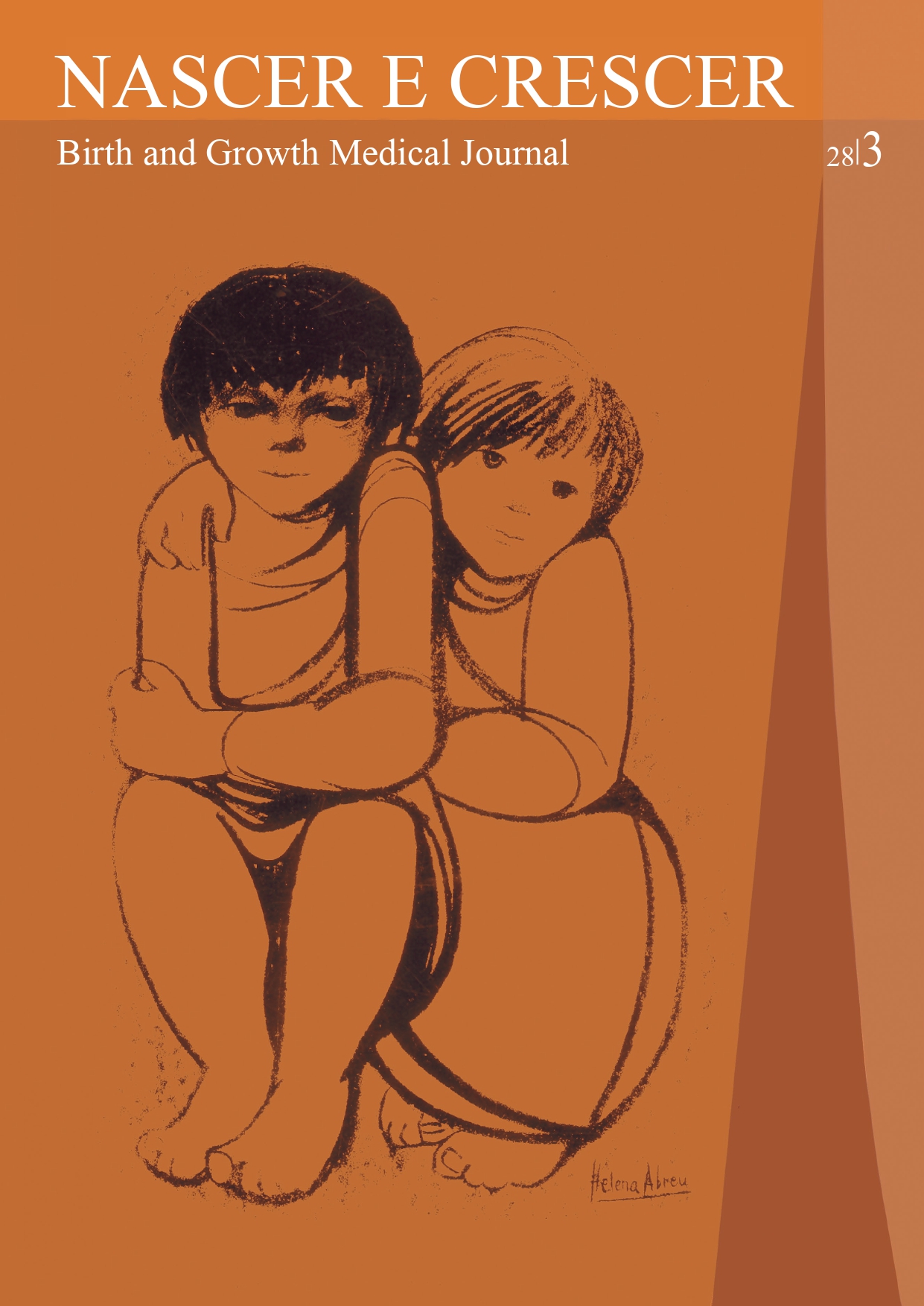Paraganglioma retroperitoneal, uma causa rara de hipertensão arterial
DOI:
https://doi.org/10.25753/BirthGrowthMJ.v28.i3.14159Palavras-chave:
catecolaminas, hipertensão arterial, paragangliomaResumo
Introdução: Os paragangliomas constituem tumores raros em idade pediátrica, que derivam do tecido simpático de localização extra suprarenal ou do tecido parassimpático. Alguns destes tumores segregam catecolaminas e são uma causa rara de hipertensão arterial.
Caso Clínico: Uma adolescente do sexo feminino, de 14 anos de idade e sem antecedentes pessoais de relevo, foi referenciada à consulta de Pediatria por episódios de cefaleia holocraniana associados a visão turva com seis meses de evolução. O exame físico e a ressonância magnética cerebral encontravam-se normais. Na consulta foi detetada hipertensão arterial estadio 1, confirmada através de monitorização ambulatória da pressão arterial. O estudo analítico, radiografia de tórax, eletrocardiograma e ecocardiograma não mostraram alterações. A ecografia renal revelou uma massa heterogénea em contiguidade com o seio renal esquerdo e a tomografia computorizada abdominal evidenciou uma lesão retroperitoneal na vertente medial do espaço perirrenal esquerdo. Perante suspeita de paraganglioma retroperitoneal, a doente foi encaminhada para o Instituto Português de Oncologia do Porto, onde realizou exérese cirúrgica da lesão, tendo o exame anatomopatológico confirmado o diagnóstico.
Discussão: Embora raros em idade pediátrica, os paragangliomas representam o tumor endócrino mais comum. Perante suspeita clínica de paraganglioma, o diagnóstico bioquímico e imagiológico é fundamental. Após o diagnóstico, é recomendada a realização de estudo genético para uma melhor abordagem e seguimento do doente. O tratamento consiste na exérese cirúrgica, sendo alcançada remissão completa em cerca de 90% dos casos.
Downloads
Referências
Gorostidi AM, Ranera AJ, Denis SEZ , et al. Feocromocitoma y paraganglioma en la infancia: a propósito de 2 casos. An Pediatr (Barc). 2015; 82 (1): e175-e180.
Santos RJ, Domingues R, Montalvão P, Magalhães M, Bugalho MJ. Paragangliomas, caracterização clínica e funcional de 40 casos. Revista Portuguesa de Endocrinologia, Diabetes e Metabolismo 2011.
Lender JWM, Duh QY, Eisenhofer G, et al. Pheochromocytoma and Paraganglioma: An Endocrine Society Clinical Practice Guideline. J Clin Endocrinol Metab, June 2014, 99 (6): 1915-1942.
Oliveira MC, Silva G, Machado R, Lima O, Ramires R, Marcelo F. Paraganglioma retro-peritoneal: Um diagnóstico raro mas importante. Acta Urológica 2009, 26; 4: 47-53.
Edmonds S, Fein D, Gurtman A. Pheochromocytoma. Paediatrics in Review 2011; 32: 308-310. 6. Ferreira MA, Vilaverde J. A genética dos feocromocitomas e paragangliomas. Ver Port Endocrinol Diabetes Metab.2014; 9(1):29-35.
Oleaga A, Goñi F. Feocromocitoma: actualización diagnóstica y terapêutica. Endocrinol Nutr.2008; 55 (5):202-16.
Correia AJM. Abordagem da Criança e Adolescentes Hipertensos. Nascer e Crescer 2007; 16 (3): 158-167.
Lurbe E, et al. 2016 European Society ofHypertension guidelines for themanagement of high blood pressure in children and adolescents. Journal of Hypertension 2016; 34.
Brady TM. Hypertension. Paediatrics in Review 2012;33;541- 552
Pham TH, et al. Pheochromocytoma and Paraganglioma in Children: A Review of Medical and Surgical Management at Tertiary Car Center. Paediatrics 2006; 118: 1109-1117.
Megías MC, Puyol DR, Rodríguez LF, Martinez GL, Miguel PM. Feocromocitoma-paraganglioma: del diagnostic bioquímico al genético.
Downloads
Publicado
Como Citar
Edição
Secção
Licença
Copyright e Direitos dos Autores
Todos os artigos publicados na Revista Nascer e Crescer – Birth and Growth Medical Journal são de acesso aberto e cumprem os requisitos das agências de financiamento ou instituições académicas. Relativamente à utilização por terceiros a Nascer e Crescer – Birth and Growth Medical Journal rege-se pelos termos da licença Creative Commons "Atribuição - Uso Não-Comercial - (CC-BY-NC)"".
É da responsabilidade do autor obter permissão para reproduzir figuras, tabelas, etc. de outras publicações.
Juntamente com a submissão do artigo, os autores devem enviar a Declaração de conflito de interesses e formulário de autoria. Será enviado um e-mail ao autor correspondente, confirmando a receção do manuscrito.
Os autores ficam autorizados a disponibilizar os seus artigos em repositórios das suas instituições de origem, desde que mencionem sempre onde foram publicados e de acordo com a licença Creative Commons.


